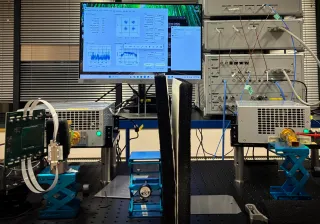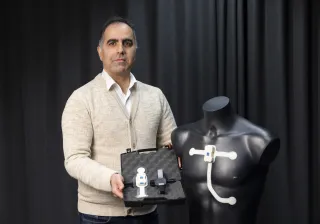A revised version of the SI system, the cornerstone of all measurements, is due to be adopted in May 2019. The reform involves redefining four base units – kilogram, ampere, kelvin and mole – and basing them on fundamental physical constants, which means that, in the future, these units can always be measured accurately using the best available technology. The reform enables the development of increasingly efficient production processes and more reliable environmental analyses.
As science and technology evolve, more and more accurate measurements are needed across more and more diverse fields. The current definitions of SI base units limit the accuracy that can be achieved. Definitions that are based on physical prototypes and material properties are particularly problematic. The aim is for all the base units to be defined on the basis of fundamental physical constants in order to enable accurate measurements in all circumstances using the best available technology. The reform also ensures that the units do not change over time.
The SI system is currently based on seven base units: metre, kilogram, second, ampere, kelvin, mole and candela. The reform involves redefining four of these – kilogram, ampere, kelvin and mole – and basing them on fundamental physical constants.
The size of the kilogram and the other base units will not change, so consumers will not notice the difference in practice. However, developers of science and technology will benefit from the better accuracy enabled by the reform.
"In the industrial sector and in trade, inaccurate measurements damage businesses' competitiveness and increase their costs. For example, measurements account for 10–15% of the total costs of industrial production processes and health care. The improved accuracy of measurements will therefore have a direct impact on businesses' financial performance. In the future, electronics and pharmaceutical manufacturing processes will involve measuring smaller and smaller quantities and even quantities as tiny as a single atom. The higher measurement accuracy enabled by the reform of the SI system will play an important role in this respect. The reform of the SI system is also expected to enable new technological and scientific discoveries that we cannot even imagine today", says Director Martti Heinonen from VTT's Centre for Metrology and Accreditation (VTT MIKES).
The kilogram, a familiar unit to everyone, is changing the most. After the reform, the size of a kilogram will no longer be based on the physical prototype kept in Paris but on the Planck constant. However, the size of a kilogram will not change thanks to the exact value agreed for the Planck constant.
The units in the new SI system will be defined on the basis of five fundamental physical constants and two constants that are based on atomic properties. The fundamental physical constants are the speed of light in vacuum, the Planck constant, the elementary charge, the Boltzmann constant and the Avogadro constant. The constants that are based on atomic properties are the ground state hyperfine splitting frequency of the caesium-133 atom and the luminous efficacy of monochromatic radiation of a certain frequency.
A formal decision on the new SI system will be made at the General Conference on Weights and Measures (CGPM) in Versailles between 13 and 16 November 2018. The new SI system will be officially adopted on World Metrology Day, 20 May 2019.
VTT MIKES is the national metrology institute of Finland and part of a worldwide network that develops the SI system and makes its units available for the industrial sector and the general public. VTT MIKES's services enable Finnish businesses to ensure and demonstrate that their measurements comply with the SI system. VTT MIKES is also home to Finland's own official prototype of a kilogram, which is compared to copies of the Paris prototype from time to time.
The kilogram before the reform:
The kilogram has been defined on the basis of the mass of a prototype kept in Paris since 1889. Several copies have been made of the prototype, including the one at VTT MIKES, No 23, which Finland received in 1890. The mass of the prototypes changes based on comparisons between the copies, but no-one knows by how much exactly. It is nevertheless clear that the mass of a kilogram is no longer what it was originally.
Copyright: BIPM - International Bureau of Weights and Measures
The kilogram after the reform:
The reform of the SI system is enabled by the Kibble balance shown in the picture, which can be used to relate mass to the strength of an electric power, which can then be fixed to the Planck constant by means of quantum phenomena. The Kibble balance is a highly sophisticated precision instrument, but research teams have nevertheless been able to build various versions of it around the world. Therefore, the size of the kilogram will no longer depend on a single prototype or device after the reform of the SI system. Fixing the kilogram to the Planck constant ensures that it will not change systematically over time either.
The ampere before the reform:
The ampere is that constant current which, if maintained in two straight parallel conductors of infinite length, of negligible circular cross-section, and placed one metre apart in vacuum, would produce between these conductors a force equal to 2 x 10-7 newton per metre of length. The current definition of the ampere is almost impossible to realise with high precision in practice. On the other hand, the newton ties the ampere to the mass of the prototype of a kilogram, which is known to change.
The ampere after the reform:
The new definition of the ampere is fixed to the elementary charge of a single electron. The most direct way to realise the new definition is to transport electrons one by one, which can be done using microscopic single-electron pumps like the one shown in the picture. This particular device, developed by VTT, is based on CMOS technology, which is also used in computer processors. The dotted lines illustrate the parts of the pump hidden by the outer layers. The turquoise structures are used to guide electrical current in the wire marked in blue. Dealing with individual electrons requires quantum phenomena and cooling the device down to within approximately one degree of absolute zero. The black-and-white electron microscope image has been coloured in by hand.





